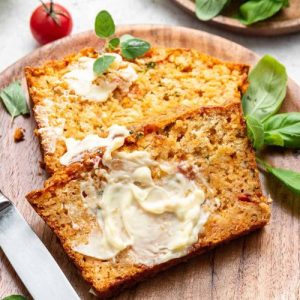This Italian Herb Tomato Bread is a flavorful, savory loaf that brings the taste of summer right to your kitchen.
Packed with fresh tomatoes, aromatic herbs, garlic, and a touch of cheddar, it’s not only delicious but also nourishing.
With a mix of plant-based goodness from tomatoes and herbs, protein from eggs and cheese, and healthy fats from vegetable oil, it’s a balanced, fiber-rich choice.
Quick to prepare and easy to bake, this bread is perfect for breakfast, snacking, or meal prep, offering a satisfying, wholesome option for everyday meals.

Italian Herb Tomato Bread
Equipment
- 1 Large mixing bowl
- 1 whisk or spoon
- 8.5 x 4.5-inch loaf pan, greased
- Food processor (optional, for chopping tomatoes and garlic)
Ingredients
- 3 cups 360 g all-purpose flour
- 1 ½ teaspoons baking powder
- 1 teaspoon baking soda
- 1 teaspoon salt
- 1 large egg
- ⅓ cup 66 g vegetable oil
- ⅓ cup 76 g milk
- 1 cup 113 g grated cheddar cheese
- 3 cloves garlic roughly chopped
- 1 lb 454 g fresh tomatoes
- Large handful fresh basil and oregano
Instructions
- Preheat and Prepare the Loaf Pan: Begin by setting your oven to 350°F (175°C) so it has plenty of time to reach an even, consistent temperature. While the oven warms, grease an 8.5 x 4.5-inch loaf pan with a thin layer of oil or nonstick spray. This ensures the bread won’t stick and will release easily once baked. You can also line the bottom with parchment paper for extra insurance against sticking. Properly preparing your pan at this stage is crucial for a neat, clean loaf.
- Combine Dry Ingredients – The Foundation: In a large mixing bowl, sift or whisk together 3 cups (360 g) of all-purpose flour, 1 ½ teaspoons baking powder, 1 teaspoon baking soda, and 1 teaspoon salt. Mixing these dry ingredients thoroughly at this stage helps the bread rise evenly and ensures that no clumps of leavening agents or salt remain. Take a moment to admire the uniform, fluffy texture—this is the backbone of your bread.
- Mix Wet Ingredients – Building Moisture: In a separate bowl, whisk together 1 large egg, ⅓ cup (66 g) vegetable oil, and ⅓ cup (76 g) milk until smooth and glossy. This combination adds richness, moisture, and structure to your bread. Once combined, stir in 1 cup (113 g) of grated cheddar cheese. The cheese will melt during baking, infusing the loaf with a savory, gooey flavor that complements the fresh tomatoes.
- Chop the Tomatoes and Garlic – Flavor Burst: Take 1 lb (454 g) of fresh tomatoes and 3 cloves of garlic (roughly chopped). Place them in a food processor along with a generous handful of fresh basil and oregano. Pulse the mixture in 10–15 short bursts, about one second each, until the tomatoes and garlic are finely chopped but not completely smooth. You want the mixture to retain some texture, so each bite has bursts of fresh, herbaceous flavor. If you don’t have a food processor, finely chop everything by hand and be sure to collect all the juices—these carry incredible flavor.
- Fold in the Tomato Mixture – Creating a Thick, Moist Batter: Gently fold the tomato and herb mixture into the dry and wet ingredients. Use a spatula to carefully combine until fully incorporated. The batter should remain thick but moist, with no dry flour pockets.If it seems too dry, add 2–3 tablespoons of milk; if too wet, fold in 2–3 tablespoons of flour. This ensures your bread has the perfect texture: soft, slightly dense, and wonderfully flavorful.
- Transfer to the Pan – Shape the Loaf: Spoon the batter into your prepared loaf pan, smoothing the top with a spatula or the back of a spoon. Take care to evenly distribute the batter so that the loaf rises uniformly. The batter will be thick and hearty, with visible chunks of tomato, herbs, and cheese throughout. This step sets the stage for a beautiful, well-structured loaf.
- Bake to Golden Perfection – The Transformation: Place the loaf pan in the center of the preheated oven. Bake for 45–50 minutes, rotating the pan halfway if your oven has hot spots. The bread is done when the top turns a golden brown and a toothpick or cake tester inserted into the center comes out clean. The smell of garlic, herbs, and baked cheese will fill your kitchen—a true sign of success.
- Cool and Release – Avoiding Soggy Bread: Allow the loaf to cool in the pan for about 10 minutes. This brief cooling period helps the bread set and prevents it from breaking when removed. Carefully turn the loaf out onto a wire rack to cool completely. Cooling on a rack ensures air circulates around the bread, maintaining a crisp crust while keeping the interior soft and moist.
- Slice and Serve – Enjoy Freshness: Once cooled slightly, slice the loaf into 12 even pieces using a serrated knife. Serve warm for the best flavor and texture. This bread pairs wonderfully with avocado, a fried egg, or as a base for savory French toast. Each slice is a perfect balance of tender crumb, savory cheese, and fresh, herby tomato bursts.
- Storage and Make-Ahead Tips – Keep It Fresh: Store leftover slices at room temperature in an airtight container for up to 3 days. For longer storage, refrigerate for up to 5 days or freeze for up to 3 months. When freezing, wrap slices individually in parchment or plastic wrap, then place in a freezer-safe bag. Reheat in a 350°F oven for 5–10 minutes for a freshly baked taste. This bread is ideal for meal prep, quick breakfasts, or an easy snack anytime.
Notes
- Use ripe, juicy tomatoes for maximum flavor and moisture; avoid underripe tomatoes as they can make the bread dry.
- If chopping tomatoes by hand, reserve all the juices and stir them into the batter for extra moisture and flavor.
- Feel free to adjust the cheese type or quantity—sharp cheddar adds more tang, while mozzarella creates a milder, gooey texture.
- Pulse gently in the food processor; over-processing can turn the tomato mixture into a puree, affecting the loaf’s texture.
- Taste and adjust herbs before mixing; fresh basil and oregano can be increased for a more pronounced herbal flavor.
- Bread can be served warm or at room temperature, but slightly warm slices release the best aroma and flavor.
- For a slightly denser loaf, reduce the milk by a tablespoon; for lighter bread, add an extra tablespoon of milk.
Chef’s Secrets For Perfect Loaf
The key to a moist and flavorful Italian Herb Tomato Bread lies in balancing moisture and texture.
Always use fresh, ripe tomatoes; they provide natural juiciness and a bright, tangy flavor.
Incorporating the juices into the batter ensures the bread remains soft and tender.
Don’t overmix once the tomato mixture is folded in—gentle folding prevents the loaf from becoming tough.
Finally, allow the bread to cool slightly in the pan before removing it to maintain structure and avoid cracking.
Serving Suggestions To Impress Guests
This bread shines on its own, lightly toasted or fresh from the oven.
For breakfast, top slices with creamy avocado, a sprinkle of salt, and a fried egg for a satisfying start.
For a savory snack, serve with herb-infused butter, cream cheese, or a slice of prosciutto.
It also makes an excellent base for savory French toast or mini sandwiches.
Pair with a fresh salad, roasted vegetables, or a bowl of soup for a complete, flavorful meal.
Storage Tips To Keep Fresh
Store your Italian Herb Tomato Bread in an airtight container at room temperature for up to three days.
If you plan to keep it longer, refrigeration extends freshness up to five days, though slightly warming slices before serving helps restore softness.
For long-term storage, freeze the loaf by wrapping it tightly in parchment or plastic wrap, then placing it in a freezer-safe bag.
Thaw at room temperature and warm in a preheated oven for 5–10 minutes to enjoy freshly baked taste and texture.
Common Questions About This Recipe
1. Can I use canned tomatoes instead?
Yes, but fresh tomatoes are ideal for texture and flavor. If using canned, drain excess liquid but retain some juice for moisture. Adjust the flour slightly if the batter becomes too wet.
2. Can I make this bread vegan?
Absolutely. Replace the egg with a flax egg or commercial egg replacer and use plant-based milk and cheese. Keep in mind the texture may be slightly denser.
3. Can I add other vegetables?
Yes! Finely diced zucchini, roasted red peppers, or spinach can be folded in for added nutrition and flavor. Make sure vegetables are well-drained to avoid excess moisture.
4. How do I know when it’s fully baked?
The loaf should be golden brown on top, and a toothpick or cake tester inserted into the center should come out clean. Slightly soft crumbs are okay; overbaking can dry it out.
5. Can I make mini loaves or muffins?
Yes, this batter works well for mini loaves or savory muffins. Reduce baking time to 20–30 minutes for smaller portions and monitor closely to prevent overbaking.
